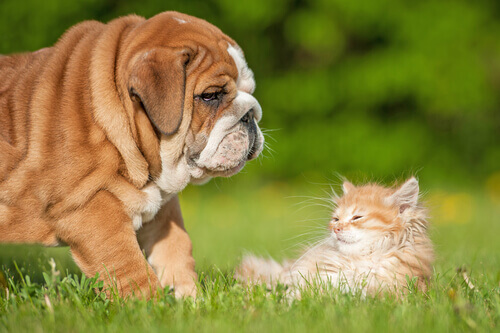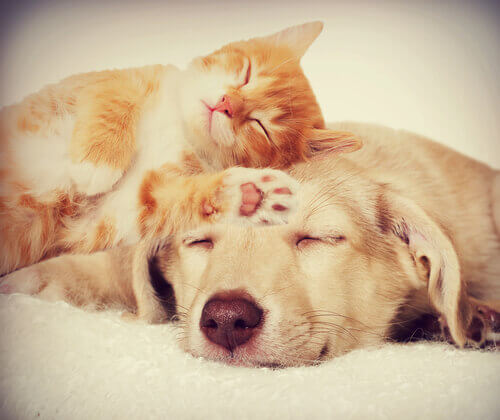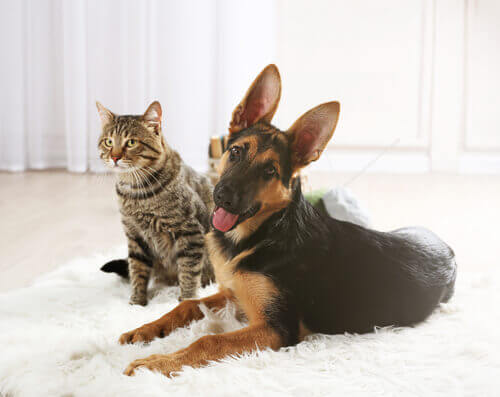How to Make Dogs and Cats Get Along

They’re such different animals. You might even think it’s impossible for them to get along. Cats are independent animals that don’t feel the need for much attention from their owner, while dogs on the other hand are easygoing creatures that live to please. So how can you make dogs and cats get along if they’re so different?
A gradual process
It’s unlikely that a dog and cat will understand each other right from the start. They each communicate in a very different way, so while one just wants to play, for the other this might seem like a threat.
These differing reactions are due to their respective instincts. For instance, a dog’s natural need to run and chase can scare a cat. On the other hand, a cat’s susceptibility can make it behave aggressively on just a little provocation.
First of all, let’s forget the idea that some specific breed is better than another when it comes to making friends with another species of animal. Take a Golden Retriever for example. Though on the surface it might appear gentle, it might have a more aggressive personality than normal. The same is true with cats; they’re not all as unsociable as they’re made out to be.
Steps to make dogs and cats get along
With the above in mind, what if you have to take your new dog or cat home to meet your current pet? What should you do to get the best results possible in a situation that could have so many different outcomes?

- If you’re not sure how they’ll react to each other, it would be best to keep both animals in separate rooms, at least during the first few days they’re in the house together. Taking this precaution can help both of them to get familiar with the other’s smell without risking a confrontation.
- Since the main identifier for dogs and cats is smell, try moving some items between both rooms. Once you’ve done this for a few days, you can then move on to getting them to meet face to face.
- Dogs are active, energetic animals that often don’t hesitate before rushing into a new situation. To keep your dog as calm as possible, it would be a good idea to take it for a long walk before it meets its new friend.
- Make sure your cat is in a spot that’s out of the reach of your dog. That way your cat can become familiar with the situation and feel in control. A sensible preventative measure would be to cut your cat’s claws first. At this first meeting, any sudden movement could cause an unpredictable reaction.
- You might find it helpful to put your dog on the leash. If it pulls on the leash, make sure it understands that’s not acceptable with a firm No. Your dog has to understand that it mustn’t be aggressive with the new animal and that it’s not an enemy, but rather a playmate.

Early socialization is the key
The environment where your pet grows up will be an essential factor when it comes to getting along with other animals and people. In that regard, the first 12 weeks of life are extremely important, since puppies and kittens tend to get along if they’re put together from a very young age.
Thanks to their young age, both animals will think of the other species as a brother or sister from their litter, that they can play with and hang out with.
But don’t forget that the differences between their anatomy and mentality may sometimes cause a slight problem. For example, a kitten may sometimes scratch while it’s playing, while a puppy tends to bite.
Meetings between adult dogs and cats
A puppy or kitten’s learning process will be much faster and more flexible than that of an adult. However, if you do decide to bring an adult animal home, all’s not lost. What other suggestions could help you?
Imagine you’re going to bring an adult cat to your home where you already have a dog. The first thing you need to make sure of is that the cat has its own space, away from the dog. If you’ve got a small room for it, such as a storage space, even better; it will give your cat the feeling of being safe and in control. Remember that this is essential for cats.
When your cat has gotten used to its new environment, bring your dog in on a lead. Respond with firm words and actions to any abrupt or sudden movements by your dog. However, don’t shout in the presence of the cat, since it’ll think you’re shouting at it.
When both animals feel a little more at ease in each other’s presence, let the cat out into other rooms of the house.
It’s really just a question of time and patience until both animals get along with each other. Dogs and cats are both guided by a hierarchy structure, so, at the end of the day, you’re the boss.